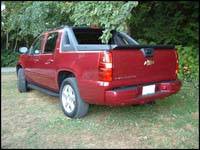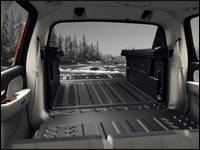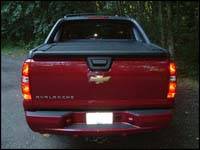Although its horsepower rating combined with a maximum torque rating of 335 foot-pounds sounds very impressive on paper, it didn't seem to
 |
| (Photo: Rob Rothwell) |
materialize under the right foot. Punch off-the-line is brisk however the Avalanche is left begging for additional highway passing power, especially on mountain ascents. If heavy towing is planned, one might want to consider an upgrade to the optional 6.0 litre V8, which culminates in 355 horsepower and 365 foot-pounds of torque. Unfortunately fuel consumption ratings are not yet available for this monster. Though its brawn sometimes feels a little pencil-necked, the Vortec 5300 is a sweet operator that is tow-rated at 3,545 kg (7,800 lb) when combined with 4WD. Unless pushed to its limits, this honey-smooth mill never sounds gruff or truck-like. Its heavily muted exhaust note quietly burbles in a cabin substantially free of wind and road noise. In both ride and operational refinement, the Avalanche is more SUV than pickup truck, which makes sense given its SUV core; the result- a vehicle that is very comfortable to spend time in, on the road or off it.
So how does the Avalanche distinguish itself from an SUV, I hear you ask. Well for those not yet versed in its ability to morph- a quick explanation.
 |
| (Photo: General Motors) |
The three solid panels covering the vehicle's cargo box can be removed to reveal a rubber-lined bed. If items too long to fit within the box require hauling, simply flip and fold the rear seat forward, remove the rear windshield and drop the mid-gate (also known as the rear wall of the cab or the rear bulkhead) and voila, the cab is completely open at the rear, providing 2.5 metres (8'2") of useable bed length. Lengthy objects can now extend into the rear portion of the open cab. Okay, it actually takes a fair bit of effort to maximize the Avalanche's cargo capacity, but do you see the versatility? Depending on seating choice, the Avalanche can carry up to six occupants when its rear seat is in place and a bench seat replaces the buckets up front.
A feature I like with the Avalanche is its electronically locking rear tailgate, which creates a secure, fairly watertight storage area when the three panels are in place over the cargo box. I also like the fact that the panels
 |
| (Photo: Rob Rothwell) |
are strong enough to stand on if necessary. Doing so makes the available roof rack much easier to access. So now that we've covered its practicality, I'd like to touch on both braking and handling qualities. The big Avy is hauled back down to earth by a full set of powerful, antilock, vented disc brakes. The pedal controlling the binders feels firm while returning excellent predictability and brake modulation. Keeping my tester square to the road and under control through the corners was GM's sophisticated AutoRide, road-sensing, electronically controlled shock absorbers with air-assisted, automatic rear self leveling (standard on LTZ). The road-holding tenacity of the so-equipped Avalanche is quite superb, although significant body lean accompanies rapid directional changes. Yet the driver feels very secure. Should a directional change be unintended, StabiliTrak - GM's vehicle stability control system with their Proactive Roll Avoidance program - will intrude with wheel-specific braking and engine retardation to quickly restore order. Kudos to GM for providing this important technology as standard Avalanche equipment.





